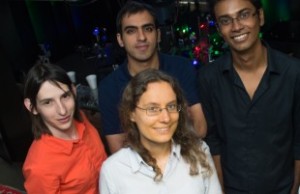
Rice University researchers (clockwise from left) Chloe Doiron, Hossein Robatjazi, Shah Mohammad Bahauddin and Isabell Thomann.
A team from Rice University, led by assistant professor and ECS member Isabell Thomann, has demonstrate a highly efficient way to harness energy from the sun though the splitting of water molecules.
Through the configuration of light-activated gold nanoparticles, the team was able to successfully harvest and transfer energy to what the scientists refer to as “hot electrons.”
“Hot electrons have the potential to drive very useful chemical reactions, but they decay very rapidly, and people have struggled to harness their energy,” said Thomann. “For example, most of the energy losses in today’s best photovoltaic solar panels are the result of hot electrons that cool within a few trillionths of a second and release their energy as wasted heat.”
If the hot electrons could be capture before they have the opportunity to cool, society could be seeing a significant increase to energy conversion efficiencies.
This from Rice University:
Thomann and her team created a system that uses the energy from hot electrons to split molecules of water into oxygen and hydrogen. That’s important because oxygen and hydrogen are the feedstocks for fuel cells, electrochemical devices that produce electricity cleanly and efficiently.
In order to keep the hot electrons hot, Thomann and her team had to find a way to separate them from their electron holes. While the hot electrons are in this low-energy state, they tend to release a great deal of their stored energy.
The way to combat this loss of energy is to quickly separate the hot electrons from their designated holes. While other scientists have attempted to achieve this before, there has not yet been much success.
“Because of the inherent inefficiencies, we wanted to find a new approach to the problem,” Thomann said. “We took an unconventional approach: Rather than driving off the hot electrons, we designed a system to carry away the electron holes. In effect, our setup acts like a sieve or a membrane. The holes can pass through, but the hot electrons cannot, so they are left available on the surface of the plasmonic nanoparticles.”
While the results warrant further study, the researcher believe this could be a step toward creating more efficient solar and renewable energy technology.
PS: Want to see more work by Thomann? Check out her meeting abstract published in the Digital Library!

